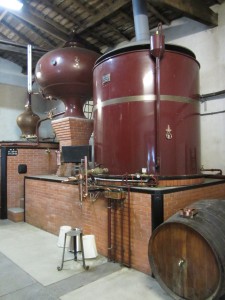How Did Double Distillation Become Part Of The Cognac Process?
 There are all manner of theories, assumptions and legends relating to the actual birth of cognac. Many relate to Chevalier de la Croix Maron, an aristocratic wine taster and Lord of Segonzac. Legend has it that on returning home from the Crusades, he found his wife in bed with his neighbour. He shot them both. But afterwards Maron could not sleep as he was plagued by dreams of Satan coming from the dark and roasting him not once but twice over a fire. One night after waking from another roasting he sat on the edge of the bed, his fingers wound round a glass of his favourite drink, burnt wine. He wondered if this recurring nightmare might be a message from above. Looking into his drink he asked his servants to distil the wine again and so provided it with a magical smoothness. Another story tells of the Chevalier finding a hidden barrel of peasant brandy in the corner of his cellar. It was too crude for his aristocratic palate, so he ordered it to be distilled again. The pure fruitiness of the double distilled brandy delighted him, and the practice of double distillation had begun.
There are all manner of theories, assumptions and legends relating to the actual birth of cognac. Many relate to Chevalier de la Croix Maron, an aristocratic wine taster and Lord of Segonzac. Legend has it that on returning home from the Crusades, he found his wife in bed with his neighbour. He shot them both. But afterwards Maron could not sleep as he was plagued by dreams of Satan coming from the dark and roasting him not once but twice over a fire. One night after waking from another roasting he sat on the edge of the bed, his fingers wound round a glass of his favourite drink, burnt wine. He wondered if this recurring nightmare might be a message from above. Looking into his drink he asked his servants to distil the wine again and so provided it with a magical smoothness. Another story tells of the Chevalier finding a hidden barrel of peasant brandy in the corner of his cellar. It was too crude for his aristocratic palate, so he ordered it to be distilled again. The pure fruitiness of the double distilled brandy delighted him, and the practice of double distillation had begun.
It is probable that the second story is nearer to the truth. The art of distillation was founded by the Moors as they travelled from the South through France. Originally, they distilled perfumes in pot stills, but they taught the peasants in Gascony how to distil their wines. Using pots heated by wood fires they extracted the vapours and then allowed them to condense back into strong and fruity spirits.
The Cognaçais also learnt the skills of distillation in order to prevent their wines from becoming rancid during the long journey along the Charente river to the port of La Rochelle. On reaching their destination they were bartered for leather, timber and copper (which was used to make their burnt wines). Wines were also distilled to reduce their volume prior to shipping to foreign ports. It was found that distilling them a second time not only reduced them further but also gave them a higher quality and finer taste.
It is also said that Chevalier de la Croix Maron took some barrels of the double reduced wine, or brandy as we know it today, to the local monastery. The monks tried some but disliked its fiery taste. Years later they opened another barrel and found that the brandy had turned golden and the flavour had changed to be rich and fruity. The benefits of barrel ageing had accidentally been discovered. It seems that the Chevalier de la Croix Maron has much to answer for in the origins of cognac!
